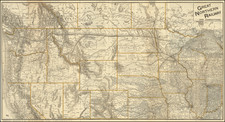Highly detailed antique map of Montana from a rare early edition of Cram's Standard American Railway Atlas.
The map shows counties, railroads, railway stations, township surveys, mountains, rivers, lakes, and a host of other early details. Includes the Flathead Indian Reservation.Also shows county seats, Money Order Post Offices, and other commerce details.
Montana Territory in the 1880s was a place of significant change and development. In the decade leading up to the 1880s, Montana had experienced a gold rush, which brought a flood of new settlers and miners to the area. This influx of people and settlement of lands led to the formation of many new counties. These counties were established to provide local governance and ensure the needs of the growing population were met.
Mining activity in Montana was a major contributor to the economy in the 1880s. Gold, silver, and copper were all mined in the territory, and the mining industry employed a large number of people. The discovery of gold in the 1860s had brought many miners to the area, and the mining industry continued to thrive in the 1880s.
In the 1880s, there were several Indian reservations in Montana. The creation of these reservations often led to conflict, as the Native Americans were often forced to give up their land and move to the reservations.There were also several American forts in Montana in the 1880s. ort Benton, Fort Missoula, and Fort Shaw were all active in the 1880s, and played important roles in the development and protection of the Montana Territory.
George F. Cram (1842-1928), or George Franklin Cram, was an American mapmaker and businessman. During the Civil War, Cram served under General William Tecumseh Sherman and participated in his March to the Sea. His letters of that time are now important sources for historians of the Civil War. In 1867, Cram and his uncle, Rufus Blanchard, began the company known by their names in Evanston, Illinois.
Two years later, Cram became sole proprietor and the company was henceforth known as George F. Cram Co. Specializing in atlases, Cram was one of the first American companies to publish a world atlas. One of their most famous products was the Unrivaled Atlas of the World, in print from the 1880s to the 1950s.
Cram died in 1928, seven years after he had merged the business with that of a customer, E.A. Peterson. The new company still bore Cram’s name. Four years later, the Cram Company began to make globes, a branch of the business that would continue until 2012, when the company ceased to operate. For the final several decades of the company’s existence it was controlled by the Douthit family, who sold it just before the company was shuttered.













![(Nothern Half) [Bancroft's Map of the Pacific States]](https://storage.googleapis.com/raremaps/img/small/54924.jpg)
![[Great Falls, Montana] Great Falls, Montana Size of Lots 50' x 150'](https://storage.googleapis.com/raremaps/img/small/85587.jpg)